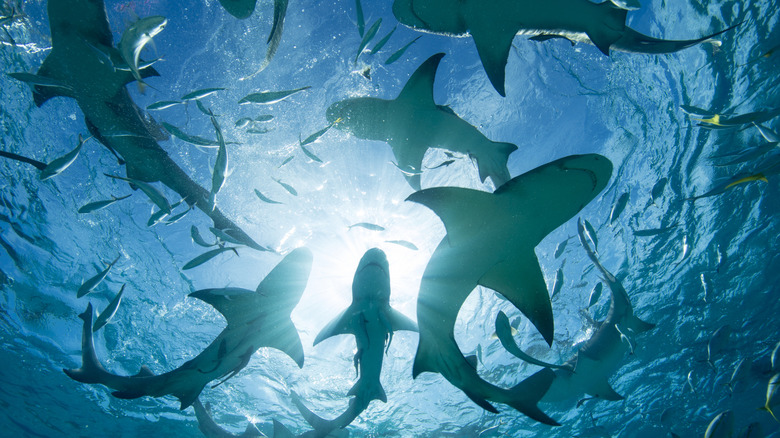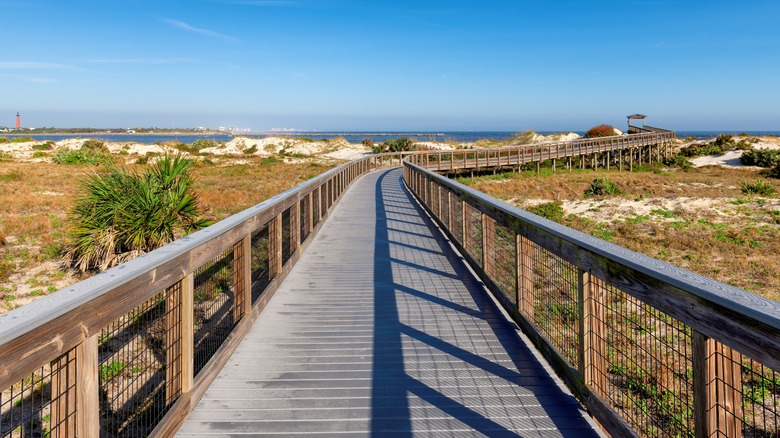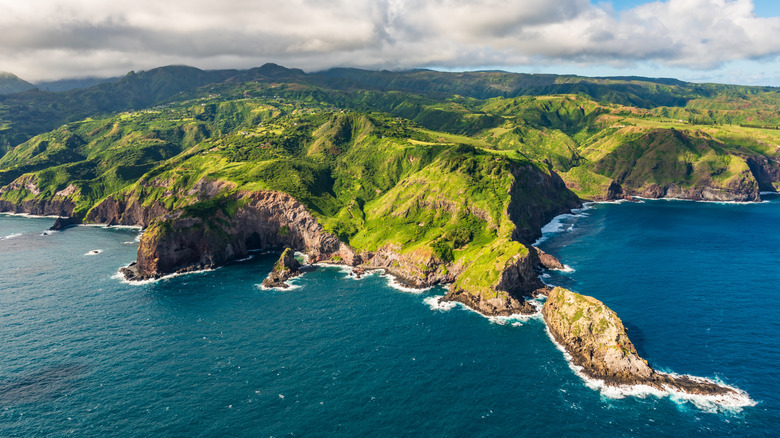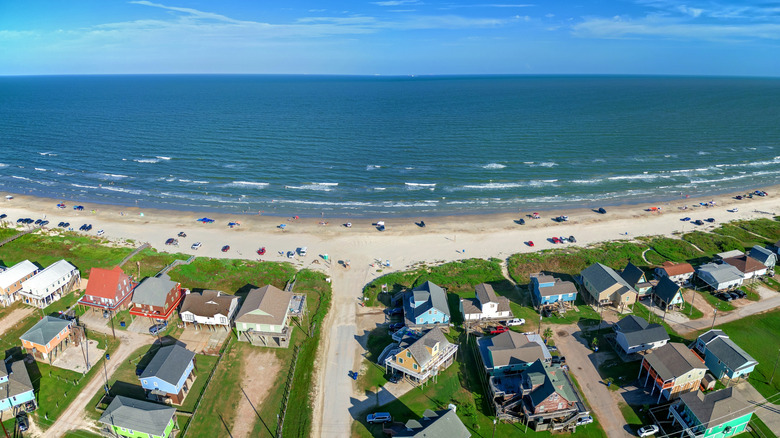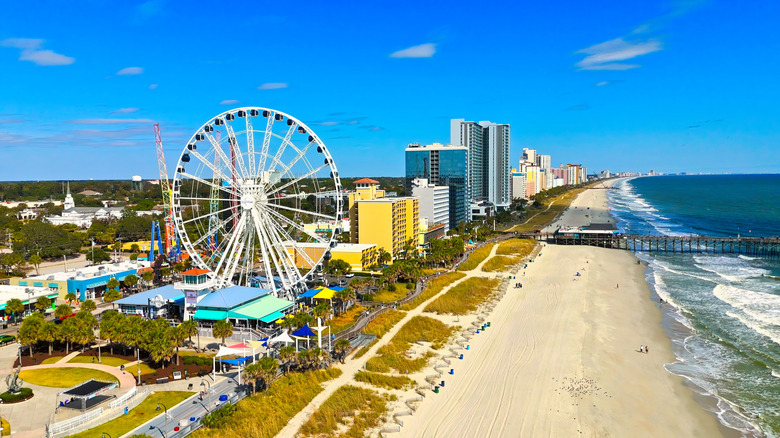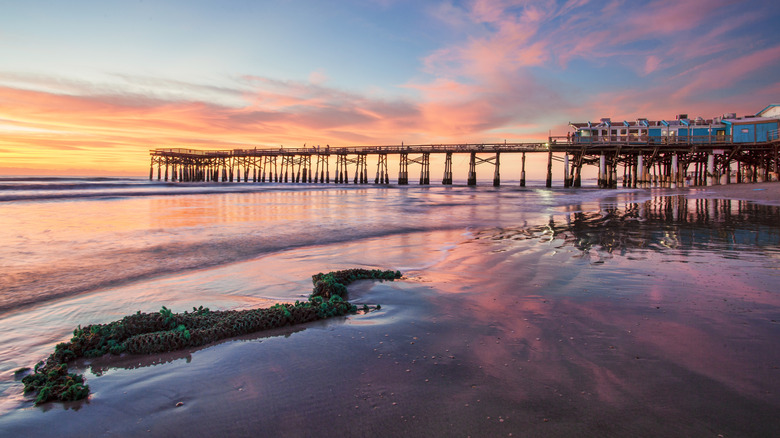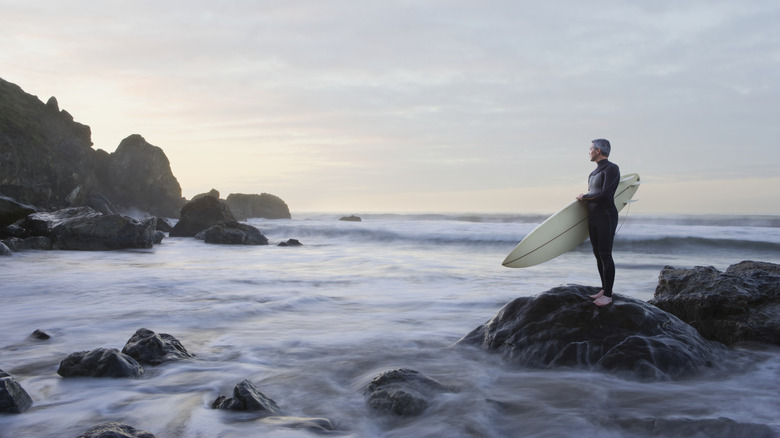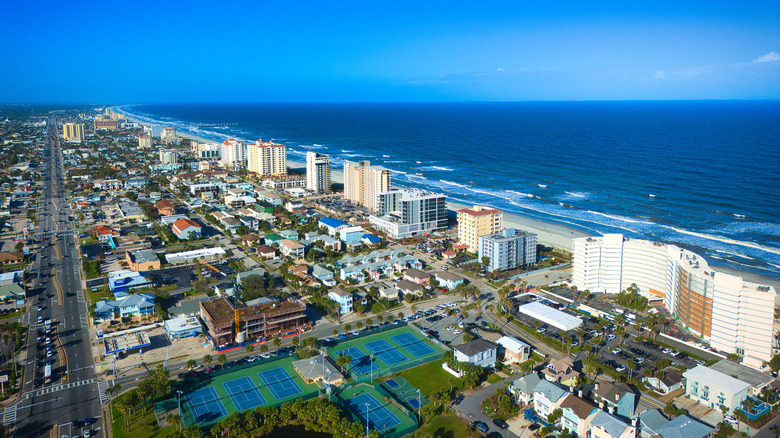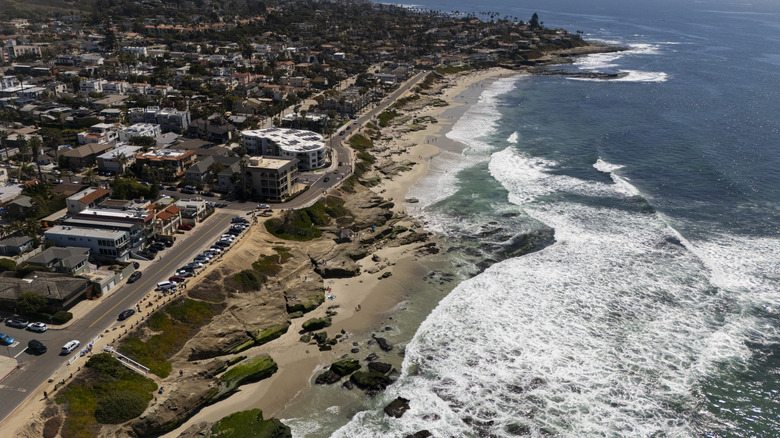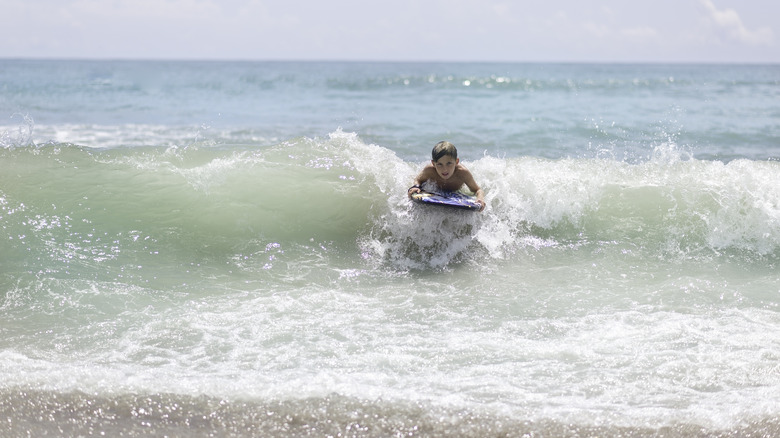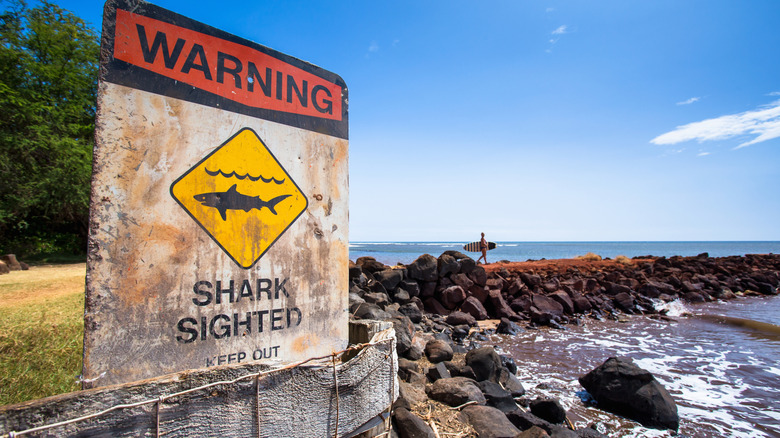These Are The Most Shark-Infested Beaches In America
As summer quickly approaches, so too do our beach getaways, but it's not all fun in the sun. While shark attacks are rare, there are a select few U.S. shorelines that have recorded their fair share of finned visitors in recent years. These are often just sightings, but sometimes, these encounters with sharks do manifest in deadly attacks for unsuspecting beachgoers.
From the palm-tree and condo-littered coastlines of Florida, Texas, and the Carolinas to the incredible golden beaches of California and the breathtaking cliffside of Hawaii, we've rounded up the American hotspots where shark encounters happen most often and are here to keep you informed about how and why these sharp-toothed marine animals often wash up on our vacation destinations. From weather patterns to food sources to shark migration maps, this list will break it all down. Whether you're a thrill-seeker looking to share the waves with these apex predators or if the very thought of a shark sends shivers down your spine, you'll need to keep these beach locations in mind for the summer season ahead.
New Smyrna Beach, Florida
The most dangerous shark-infested beach in the United States is New Smyrna Beach, Florida. In fact, this sunny locale is not only locally infamous, but it's also internationally known for its high number of shark encounters. Business Insider has even gone so far as to dub it "the shark bite capital of the world." The entire state of coastal Florida is a hotbed of shark activity, but there seems to be an alarming amount of activity around this Volusia County location.
With 259 non-fatal shark bites recorded in the Sunshine State between 2012 and 2021, 32 of those incidents were recorded on New Smyrna Beach (as detailed by the Florida Museum). There are ways to vacation safely on New Smyrna Beach, however. For instance, your likelihood of encountering a shark in these waters decreases if you avoid water sports such as surfing and other board sports.
While the waves at New Smyrna Beach are ideal for surfing, it is also a very dangerous place to be spending hours on end in deep water. While the nutrient-rich waters are heaven for tiny, harmless fish like mullets and menhadens, it's these species that are like caviar to sharks — and multiple different kinds of shark at that. So, you add an influx of yummy fish and surfers wading far out from the coastline, and what do you get? An exponentially high number of shark encounters.
North Shore, Oahu, Hawaii
The Hawaiian island that might just be a perfect breeding ground for sharks is the picturesque North Shore in Oahu. Despite its dramatic cliffside and rich turquoise waters, this seemingly postcard-perfect island is more dangerous than you might initially think. In June of 2024, local news outlets reported that a 20-year-old tourist had been bitten by a shark on the North Shore beach of Waikoloa, an attack that came just days after the fatal shark attack that tragically took the life of Tamayo Perry, a local lifeguard and famed surfer.
These two encounters are indicative of a long-standing issue with sharks crowding Hawaii's North Shore. The leading perpetrators are tiger sharks — large hunter sharks that derive their name from the tiger-like stripes marked down the sides of their trunks. Carnivorous and known to stalk tropical and sub-tropical waters, it's no surprise to scientists that tiger sharks have made a home for themselves off the coast of the North Shore.
However, many a surfer and a swimmer have been surprised to see a fin poking out of the water — or even worse, to feel a set of sharp teeth clamping down on their flesh. Over the past 20 years, Oahu has recorded 35 shark encounters on its shores. And while the number of these encounters that end in fatalities is fewer, it's still important to remain aware of the possibilities in Oahu's water and the surrounding beaches.
Surfside Beach, Texas
Believe it or not, this "tropical" Texas region with beaches, quaint towns, water sports, and seafood shacks has also seen an alarming number of shark encounters throughout the years. Surfside Beach, one of the many pockets of surf along the Texas Gulf coast, is a popular spot for Spring Breakers and summer vacationers alike. However, those planning a trip to this hidden gem only a few short hours from Austin should also be aware of what might be lurking in the waters. The first recorded incident of a shark bite occurred in 1989 when a 4-foot-long shark attacked the leg and foot of a 12-year-old boy. The next attack occurred in 2013 when a 15-year-old boy was bitten by a shark only 50 yards away from the shoreline.
Luckily, neither of these boys lost their lives following their shark encounters, but it's hard for brief news reports to account for years of trauma, blood loss, and physical scarring that likely occurred following these attacks. A fisherman interviewed by Click 2 Houston following the 2013 incident is quoted as simply saying, "We've heard that there are a lot of sharks out here." This was proven once more in 2022 when a large shark of an unidentified species was discovered only 100 yards away from the Surfside Beach shoreline. The five shark species most commonly found in Texas are the Atlantic sharpnose, blacktip, bonnethead, bull, and spinner. No matter the species, these sea beasts are best avoided.
Myrtle Beach, South Carolina
South Carolina's hidden hippie beach haven is not all Ferris wheels, mini golf, and boogie boards. Despite its fun-wheeling reputation, Myrtle Beach is also known as a magnet for sharks. Although the last fatal incident was recorded nearly two centuries ago in 1852, 2024 saw two people nipped by a shark off the Myrtle Beach coast, resulting in minor injuries.
With small species of sharks — like blacktips, spinners, and sandbars — attracted to these waters, it's easy for these sand-scrubbing sea animals to crawl close to the shoreline and surprise unsuspecting vacationers. Blacktips are the biggest offenders and are often the culprits behind hand chomps and leg bites that sometimes occur on popular beaches in the area.
A marine biologist and member of the South Carolina Department of Natural Resources, Bryan Frazier revealed to The Sun News that the state of South Carolina usually records four shark bites every year, and Myrtle Beach is a hotspot of activity. "If you're flying over Myrtle Beach," Frazier says, "you can see big sharks roaming around. They might even be swimming around people, and you would never know." How to stay safe? Stay clear of shiny objects and schools of fish, and by no means should you get in the water if you're bleeding.
Brevard County, Florida
Coming in at a sharp second for the most shark encounters in the state of Florida are the beaches nestled in Brevard County. Second only to Volusia County, Brevard County has been an epicenter of shark activities for centuries. Since the first attack was recorded in 1882, officials have documented 160 shark attacks.
Most recently, in January 2025, a massive shark was spotted gliding along the coasts of Titusville, a town in Brevard County. Stretching out to an impressive 13 feet and weighing 1,300 pounds, the great white shark — which was given the name "Bob" by the nonprofit research group OCEARCH — was something of an anomaly in this Atlantic Ocean area.
The most common sharks spotted in Brevard County are blacktip and tiger sharks. And although tiger sharks can grow up to 25 feet and are infamous for their aggressive nature, nothing beats the terrifying nature of a great white shark, which is the largest predatory fish on the globe. With 300 skin-pricking teeth, the great white is known for not chewing its food. Instead, this apex predator tears its live prey into smaller bits and then swallows it whole. Although no human came in contact with "Bob" during his tenure in Titusville, his presence is a red flag for those wishing to visit a Brevard County beach in the future.
Stinson Beach, California
There are dozens of places to explore on California's awe-inspiring coast. Stinson Beach is one such option, and while it is known for its sugar-white beaches and rocky vistas, it is also known for its large population of great white sharks. The National Park Service warns potential visitors that, while attacks are rare, large mackerel sharks like to roam close to the coastline where vacationers just might be wading in with their friends and family.
As far back as 1998, visitors to this North California locale have had tragic encounters with these "Jaws"-like animals. In that year, a 16-year-old boogie-boarder was attacked by a great white just 50 yards away from the Stinson Beach shore. Just a few years later, in 2002, an unidentified shark measuring 12 to 14 feet bit a surfer who was catching some waves.
In 2023, an unidentified man was reported missing off the coast not far from Stinson Beach, with callers to the San Francisco Coast Guard claiming that they had witnessed what looked like a shark attack. After days of search efforts, local news outlets broke the news that a kite surfer — Felix Louis N'Jai — was the apparent victim. It seems that a day out with friends was interrupted when N'Jai was attacked by a shark while swimming with pals in the Pacific waters. And while taking a dip at Stinson Beach is not always this dangerous, future beachgoers need to be aware of the risks they are taking by visiting such a shark-infested destination.
Jacksonville Beach, Florida
Don't let the tennis courts and high-rise condos fool you, as this glimmering Florida location has been ranked as one of the deadliest beaches in America. Since 2010, Jacksonville Beach has seen three fatal shark attacks occur off its coasts. A local news station — News 4 Jax — amended that count by adding that there could potentially be more shark victims, as it can sometimes be difficult to confirm whether a death or disappearance in the water has been caused by a shark.
Species often found floating in these waters include tiger and great white sharks. Blending these two species is a recipe for disaster, as tiger sharks are known to be aggressive creatures who actively hunt humans. And while great whites do not purposefully go after people, it is believed that attacks often occur because these predators mistake a surfer or a swimmer for a seal, which is their usual dinner fare. In a line-up, great whites and tiger sharks come out as the top two species of sharks to have the highest human body counts.
In February 2025, OCEARCH located a large great white shark swimming in the northwest Atlantic Ocean, not far from the shores of Jacksonville Beach. OCEARCH dubbed him a "Contender," measuring the mature male's length to 13.8 feet and his weight at 1,652.8 pounds. The shark was reportedly the largest ever tagged by OCEARCH and is proof of what might be lurking under the waters at Jax Beach.
Palm Beach, Florida
Sharks sure do love the Sunshine State. Despite its glitzy reputation, Palm Beach isn't just famous for luxury resorts and pristine beaches — it's also one of the most shark-infested shorelines in America. Thanks to its location along the Gulf Stream (the second largest ocean current in the world), the waters off the coast of Palm Beach are continually teeming with fish, corals, sponges, and more.
It's these nutrient-rich conditions that entice sharks to the area. In fact, it's the third most shark-infested location in the state of Florida, with 83 unprovoked shark attacks being recorded in the area since the 1800s. In recent years, hammerheads, tiger sharks, and even great whites have all been spotted patrolling the waters off the coast of Palm Beach.
While fatal attacks are few and far between, it's not rare to hear of beachgoers spotting these apex predators from a distance or even read headlines about non-fatal shark bites occurring across Palm Beach. In 2023, a local swimmer was only 100 yards away from the shore when his arm was bitten by a shark. Luckily, the West Palm Beach citizen survived the attack, but he reports that the incident left his arm looking like "a Halloween prop," painting quite a gory image of the reality of these bloody shark encounters.
Maui County, Hawaii
Maui's "untouched coastline" is a beautifully rugged bay to snorkel, swim, and escape crowds, but it is also a region that experiences a high number of shark encounters. The Department of Land and Resources reports that there have been 62 shark encounters on Maui's coasts since 1995, all to varying degrees of harm. While many individuals walked away from their shark battles without the need for medical intervention, seven victims tragically lost their lives.
These shark-infested waters are mostly occupied by only one species of shark — the tiger shark. These striped fish are in love with Maui and are often seen prowling around the Pacific waters that vacationers and Hawaiian locals alike consider their playground. Unlike other coastal areas where tiger sharks frequent, researchers found that Maui's tiger sharks have a "high residency" rate, leading them to believe that the Maui Nui insular shelf is especially rich in food for these predators and that the conditions for breeding here are nearly perfect. So, if you're planning a Hawaiian getaway any time soon, take the necessary precautions, and don't be too alarmed if you see a finned creature swimming just on the horizon — it's their home, too!
San Diego County Beaches, California
San Diego County's beaches may be known for their golden sands and epic surf, but they're also a hotspot for some of the ocean's most famous predators. Thanks to its warm waters, rich marine ecosystem, and proximity to deep-sea canyons, this stretch of California coastline is a frequent gathering place for sharks — especially species like the leopard, horn, and sevengill sharks.
Recently, there has been an influx of juvenile white sharks flocking to the San Diego area. Some of the beaches where these younglings have made their home are Solana Beach, Del Mar, and Torrey Pines. In 2024, one of these great white sharks that had grown up to its full potential attacked a swimmer on Del Mar beach. The swimmer, Caleb Adams, was only 100 yards away from a lifeguard when the incident occurred. Adams survived the incident, and his injuries were treated. However, these documented attacks are important reminders to beachgoers that these waters are very much part of the sharks' domain.
Kauai County, Hawaii
Kauai's breathtaking beaches and turquoise waters may look like paradise, but danger lurks here. Beneath the surface, you'll find some of the ocean's most formidable predators. As a shark-active region, Kauai County officials have recorded 24 shark attacks since 1997, with the most recent incident occurring in Hanalei Bay in 2023.
The waters around Kauai just so happen to have the perfect conditions for breeding, with tiger sharks often parking themselves off the coasts of Kauai to give birth to their pups. Other less aggressive species of sharks that are often spotted on this Hawaiian slip of paradise are hammerheads and shallow water creepers like the Gray Reef Shark and the Blacktip Reef Shark.
While shark attacks don't happen every day, they do happen, making these waters both thrilling and a little nerve-wracking for swimmers and surfers. Whether you're an adrenaline junkie hoping for a glimpse of a tiger shark or just want to be aware of what's lurking below, Kauai County's beaches are a stunning yet shark-active destination that demands both awe and respect.
Emerald Isle, North Carolina
North Carolina might not be the first state that comes to mind when you think about beach paradises, but believe it or not, the Tar Heel State is also home to a secret coastal region that offers just as much marine mystery as it does fun in the sun. Just look at the seaside town of Emerald Isle, which welcomes in just as many sharks to its shores as it does summer vacationers. In beautiful surroundings like this, who can blame the sharks?
Sitting along the warm waters of the Atlantic Ocean, this beach town is part of North Carolina's Crystal Coast and has a reputation for being a superhighway for sharks in their seasonal migration paths. Species like blacktip, spinner, and bull sharks are among the most common visitors, often drawn in by the area's abundant fish populations and continental shelf waters.
The presence of sharks here is a reminder that nature still runs the show, adding a bit of thrill to the otherwise tranquil waters. So, whether you're scanning the horizon for fins or simply soaking up the sun, one thing's for sure — this North Carolina gem is as wild as it is beautiful.
Methodology
To determine the most shark-infested beaches in America, we dove into the data, analyzing reports from marine biologists, shark tracking organizations, and local news sources that have documented everything from sightings to bites to fatal attacks. To truly break down the phenomenon of these high numbers, we considered environmental factors like weather patterns and ocean currents.
In the end, we determined that warm waters, high numbers of prey fish and other mammals, as well as seasonal migration routes all play a role in turning some shorelines into shark hotspots. Whether it's the great whites patrolling the Atlantic or the bull sharks cruising the Gulf, certain beaches consistently see more finned visitors than others. And while shark attacks remain rare, these locations have the highest frequency of encounters, making them prime destinations for thrill-seekers — or places to avoid if you'd rather keep your beach days bite-free.
